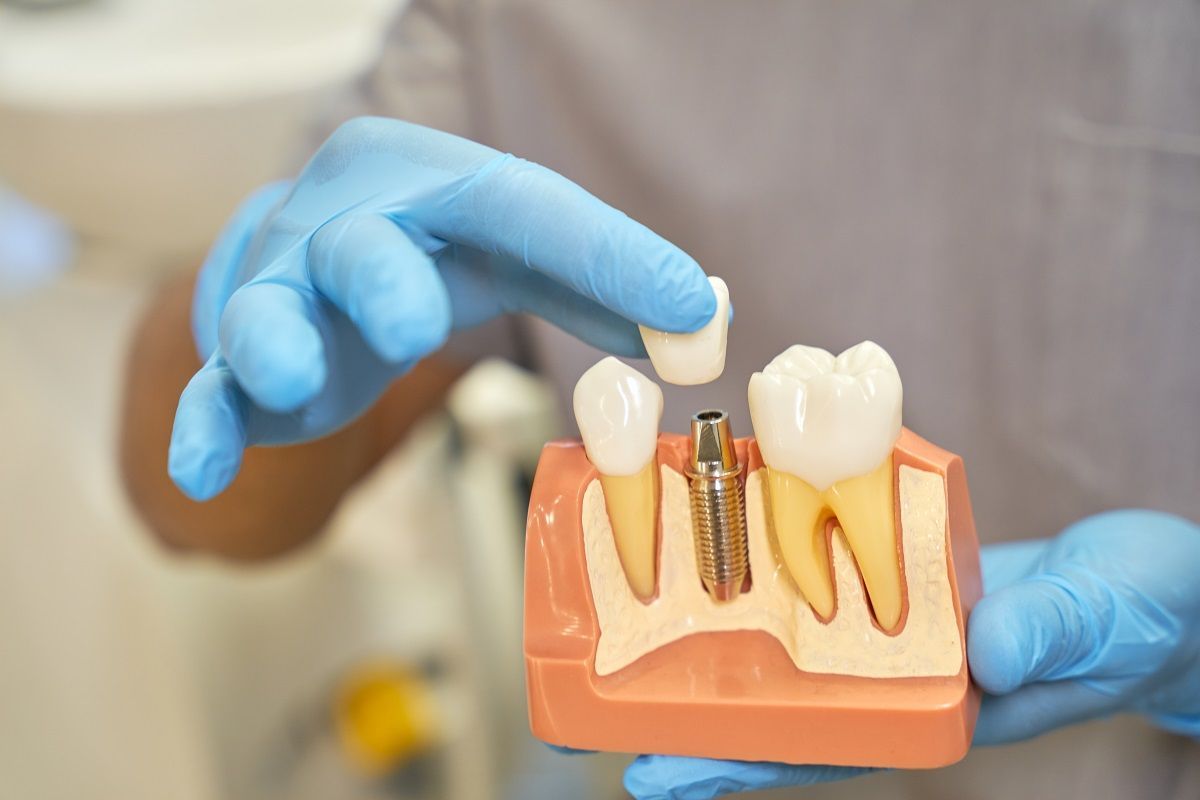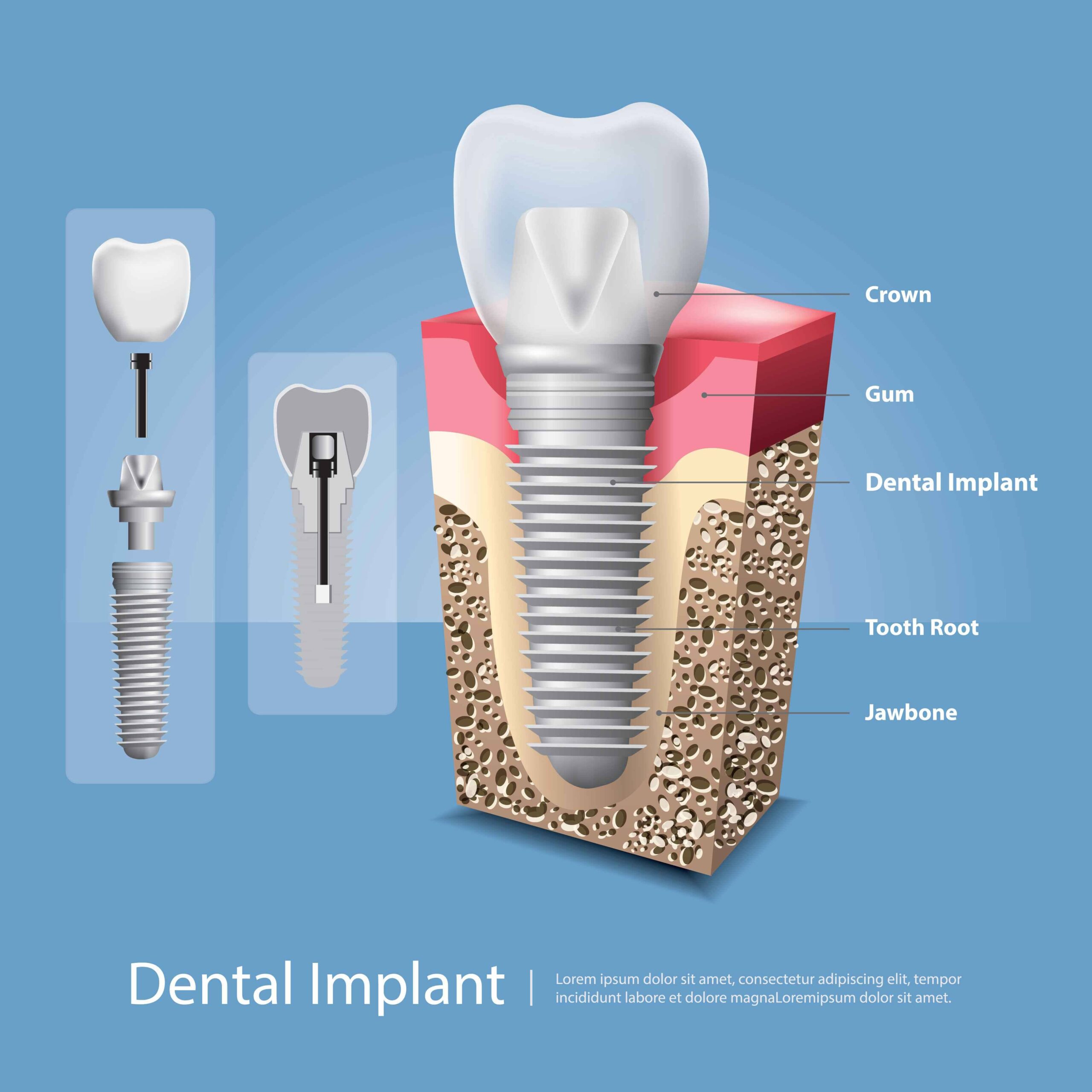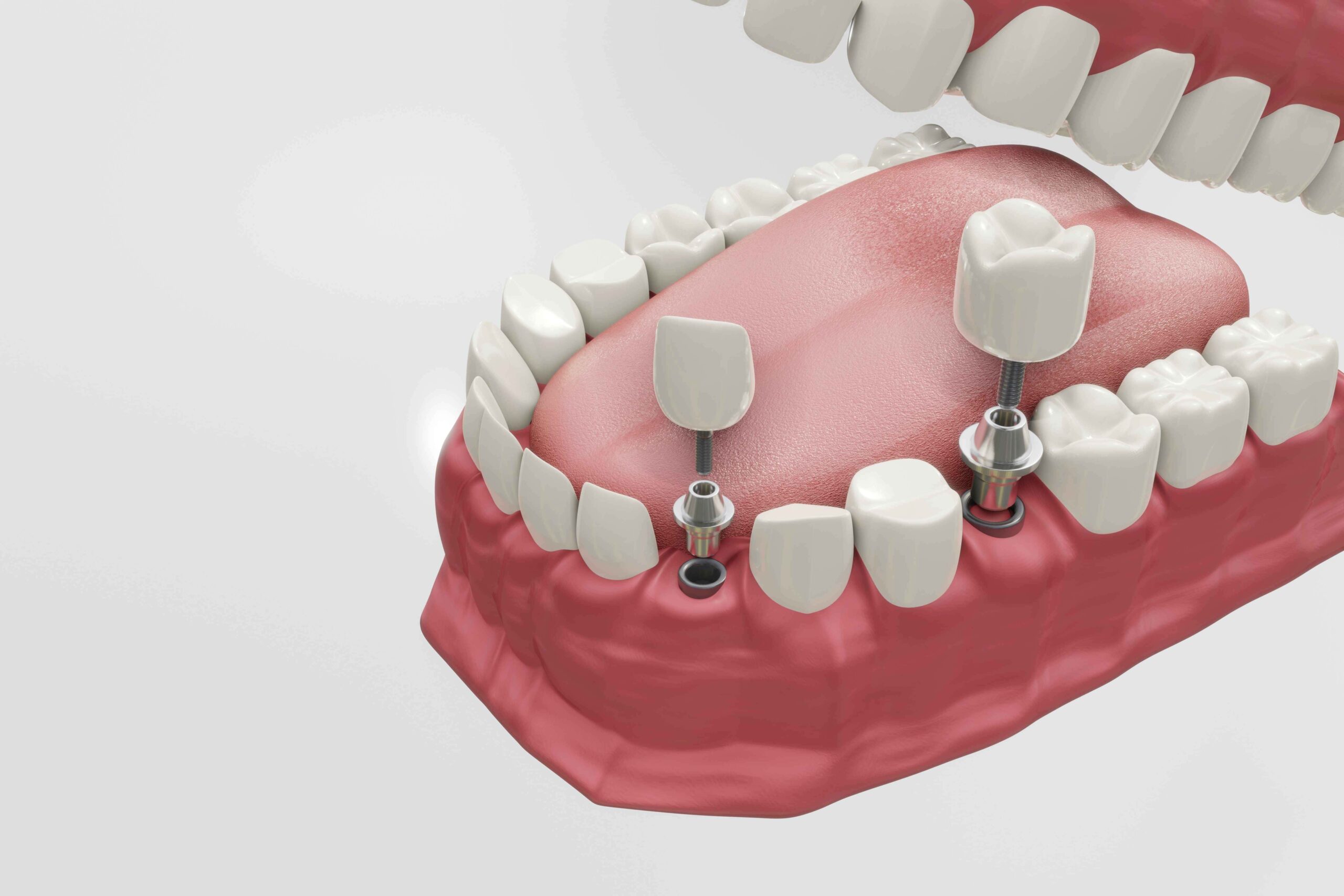Schedule your initial consultation today and start your journey towards a pain-free, healthier smile. Contact us now!

Dental implants are designed to replace natural tooth roots and support dental restorations. They support replacement “teeth” on top of them, such as custom crowns or bridges. Implants provide stable support for multiple dental restorations. Dental implants are made of biocompatible materials, typically titanium, which naturally fuse with the surrounding bone tissue and become a permanent part of your smile.
Implants provide a stable foundation for reconstructing your smile and can last a lifetime with proper maintenance. Notably, they’re also non-invasive to neighboring teeth, making them the preferred option for tooth replacement.
Missing teeth can have significant effects on your oral health over time. That might be the case initially, but over time, missing just one tooth can actually have a big impact on your oral and overall health.
Over time, the teeth surrounding the missing tooth will begin to shift. The adjacent teeth will lean into the empty space and the tooth opposing it will start to supra-erupt, which means it will erupt down (or up) into the empty space. That can cause misalignment and other problems if you choose to restore the missing tooth in the future.
Your chewing function is impaired when missing teeth. All of our teeth work together to carry the pressure of biting and chewing. When teeth are missing, that pressure transfers to the remaining teeth which leads to an increased risk for fractures and deterioration. If there are enough teeth missing, you may not be able to eat a proper nutritional diet. Poor eating habits can be especially detrimental to a patient with underlying health conditions such as diabetes.
Lastly, once a tooth is removed the bone that supported that tooth will begin to shrink. The body knows it’s no longer necessary. Missing teeth can affect jaw structure and facial appearance over time. Your jaw will begin to have a “sunk-in” appearance. Once too much of the bone has been lost, restoring the area can be nearly impossible.
Explore our budget-friendly payment options.
At My Dental Home, our goal is to make quality dental implant treatment accessible to all. That’s why we offer several different payment options to meet a variety of budgets.
Our financial coordinators will help you determine your cost with or without insurance coverage, and then work with you to find a payment plan you can afford.
There are different types of dental implants we use in our Swartz Creek dentist’s office based on your preferences and how many teeth are missing. These options provide patients with a variety of choices when it comes to restoring their smile.
Individual dental implants are an excellent option for our Swartz Creek patients who have lost a single tooth in one area of their mouth. The procedure involves placing a titanium implant into the jaw, which then integrates with the supporting bone. Then we place a crown over the implant, which is custom-made to match the size, shape, and color of your natural teeth. When you smile, the dental implant should be indistinguishable from the other teeth in your mouth.
An implant-supported bridge is a great alternative to traditional bridges and dentures that rely on adjacent teeth for support. Implant-supported restorations provide a more stable and comfortable solution for patients who are missing multiple teeth. Similarly, they do not require cutting down or altering the shape of your adjacent teeth. Because dental implants are incredibly strong, we can use them in pairs to support the weight of a multi-tooth restoration (such as a multi-tooth dental bridge.)
The dental implant procedure is typically performed in a few stages over the course of about six months. The first step involves surgically placing the implant into the bone. Dr. Khoury uses 3D-guided imaging technology to ensure highly accurate placement and minimally invasive installation. This approach means a quicker procedure and faster recovery time for our patients. We also offer in-house sedation, allowing you to fully relax throughout your implant surgery.
Next, your implant is left to fuse with the bone in a process called osseointegration. This process can take a few months, during which our patient may wear a temporary restoration.
Once the osseointegration process is complete, the abutment, a small connector post, is attached to the top of the implant. After the abutment is attached, our Swartz Creek implant dentist takes an impression, which is used to craft a custom restoration such as a bridge or crown. The restoration is then attached to the abutment, creating a natural-looking and functional replacement tooth.


Step 01 - Extraction and Placement
Following an initial consultation, we'll be ready to extract your tooth and place the dental implant.
After your implant surgery, the site will need to heal for approximately 4 months. This allows enough time for the implant to integrate with the bone.
Step 02 - Impressions
Once the healing phase is finished, you'll return to the office for impressions.
We send those impressions to a lab, which takes about 2-3 weeks to fabricate the final restoration.
Step 03 - Final Restoration
On your very last visit, we'll place the implant crown. An abutment will connect your implant to the crown, which will then be cemented into place.
Step 01 - Extraction and Bone Graft
Sometimes, there is not enough bone to place an implant right away. Instead of placing an implant on the day of the extraction, we will extract the tooth and place a bone graft. A bone graft is completed using bone or a substitute material that can rebuild the bone.
Step 02 - Implant Placement
The bone graft will need approximately 4-6 months to heal. Then, we are ready to place the implant.
The implant needs another 4 months to finish osseointegration, the process by which the implant fuses with the jaw bone.
Step 03 - Impressions
Once the healing phase is finished, you'll return to the office for impressions. We send those impressions to a lab, which takes about 2-3 weeks to fabricate the final restoration.
Step 04 - Final Restoration
On your very last visit, we'll place the implant crown. An abutment will connect your implant to the crown, which will then be cemented into place.
Step 01 - Bone and Tissue Regeneration
If a tooth has been missing for a while, we may need to perform a bone graft and tissue generation so there is adequate supporting structure for the implant.
At the first visit, we'll perform these two procedures and then allow approximately 4-6months of healing time
Step 02 - Implant Placement
The next step is the dental implant surgery. Following surgery, the implant needs another 4 months to finish osseointegration, the process by which it fuses to the bone.
Step 03 - Impressions
Once the healing phase is finished, you'll return to the office for impressions. We send those impressions to a lab, which takes about 2-3 weeks to fabricate the final restoration.
Step 04 - Implant Crown
On your very last visit, we'll place the implant crown. An abutment will connect your implant to the crown, which will then be cemented into place.
If you have missing teeth, we encourage you to schedule a consultation with Dr. Khoury at My Dental Home in Swartz Creek, MI. During your consultation, Dr. Khoury will take a 3D scan of your oral anatomy and discuss your treatment options. We provide customized treatment plans tailored to meet your specific dental health goals. Our team is committed to providing patients with the highest level of care and ensuring that each patient achieves a healthy and beautiful smile.
Contact our office today to learn about flexible financing plans for dental implants.


We are proud to call Swartz Creek, MI home, and happily provide the best quality dental work that Swartz Creek has to offer. At My Dental Home, we are happy to help with any dental questions you might have.
Mon, Tue
Closed
Wednesday
10:00 am – 7:00 pm
Thursday
10:00 am – 7:00 pm
Friday
8:00 am – 4:00 pm
Sat, Sun
Closed
Copyright © 2025 All Rights Reserved. Website by TechYouKnow